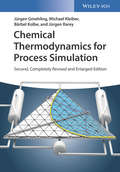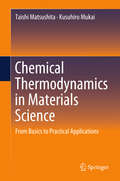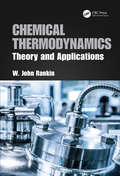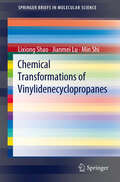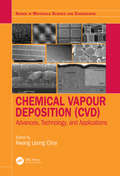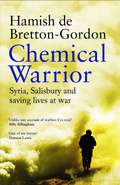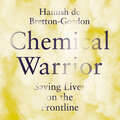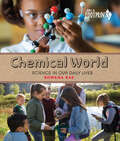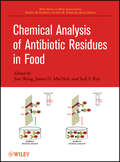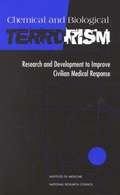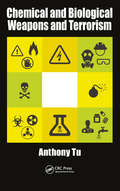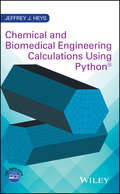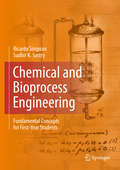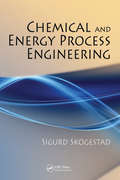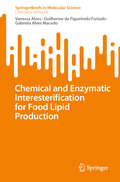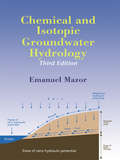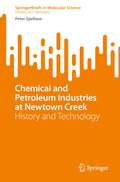- Table View
- List View
Chemical Thermodynamics and Information Theory with Applications
by Daniel J. GrahamThermodynamics and information touch theory every facet of chemistry. However, the physical chemistry curriculum digested by students worldwide is still heavily skewed toward heat/work principles established more than a century ago. Rectifying this situation, Chemical Thermodynamics and Information Theory with Applications explores applications dra
Chemical Thermodynamics for Process Simulation
by Jürgen Gmehling Michael Kleiber Bärbel Kolbe Jürgen RareyThe only textbook that applies thermodynamics to real-world process engineering problems This must-read for advanced students and professionals alike is the first book to demonstrate how chemical thermodynamics work in the real world by applying them to actual engineering examples. It also discusses the advantages and disadvantages of the particular models and procedures, and explains the most important models that are applied in process industry. All the topics are illustrated with examples that are closely related to practical process simulation problems. At the end of each chapter, additional calculation examples are given to enable readers to extend their comprehension. Chemical Thermodynamics for Process Simulation instructs on the behavior of fluids for pure fluids, describing the main types of equations of state and their abilities. It discusses the various quantities of interest in process simulation, their correlation, and prediction in detail. Chapters look at the important terms for the description of the thermodynamics of mixtures; the most important models and routes for phase equilibrium calculation; models which are applicable to a wide variety of non-electrolyte systems; membrane processes; polymer thermodynamics; enthalpy of reaction; chemical equilibria, and more. -Explains thermodynamic fundamentals used in process simulation with solved examples -Includes new chapters about modern measurement techniques, retrograde condensation, and simultaneous description of chemical equilibrium -Comprises numerous solved examples, which simplify the understanding of the often complex calculation procedures, and discusses advantages and disadvantages of models and procedures -Includes estimation methods for thermophysical properties and phase equilibria thermodynamics of alternative separation processes -Supplemented with MathCAD-sheets and DDBST programs for readers to reproduce the examples Chemical Thermodynamics for Process Simulation is an ideal resource for those working in the fields of process development, process synthesis, or process optimization, and an excellent book for students in the engineering sciences.
Chemical Thermodynamics for Process Simulation
by Jürgen Gmehling Michael Kleiber Bärbel Kolbe Jürgen RareyThe only textbook that applies thermodynamics to real-world process engineering problems This must-read for advanced students and professionals alike is the first book to demonstrate how chemical thermodynamics work in the real world by applying them to actual engineering examples. It also discusses the advantages and disadvantages of the particular models and procedures, and explains the most important models that are applied in process industry. All the topics are illustrated with examples that are closely related to practical process simulation problems. At the end of each chapter, additional calculation examples are given to enable readers to extend their comprehension. Chemical Thermodynamics for Process Simulation instructs on the behavior of fluids for pure fluids, describing the main types of equations of state and their abilities. It discusses the various quantities of interest in process simulation, their correlation, and prediction in detail. Chapters look at the important terms for the description of the thermodynamics of mixtures; the most important models and routes for phase equilibrium calculation; models which are applicable to a wide variety of non-electrolyte systems; membrane processes; polymer thermodynamics; enthalpy of reaction; chemical equilibria, and more. -Explains thermodynamic fundamentals used in process simulation with solved examples -Includes new chapters about modern measurement techniques, retrograde condensation, and simultaneous description of chemical equilibrium -Comprises numerous solved examples, which simplify the understanding of the often complex calculation procedures, and discusses advantages and disadvantages of models and procedures -Includes estimation methods for thermophysical properties and phase equilibria thermodynamics of alternative separation processes -Supplemented with MathCAD-sheets and DDBST programs for readers to reproduce the examples Chemical Thermodynamics for Process Simulation is an ideal resource for those working in the fields of process development, process synthesis, or process optimization, and an excellent book for students in the engineering sciences.
Chemical Thermodynamics in Materials Science: From Basics to Practical Applications
by Taishi Matsushita Kusuhiro MukaiThis textbook covers chemical thermodynamics in materials science from basic to advanced level, especially for iron and steel making processes.To improve a process by applying knowledge of thermodynamics or to assess the calculation results of thermodynamic software, an accurate and systematic understanding of thermodynamics is required. For that purpose, books from which one can learn thermodynamics from the basic to the advanced level are needed, but such books are rarely published. This book bridges the gap between the basics, which are treated in general thermodynamic books, and their application, which are only partially dealt with in most specialized books on a specific field.This textbook can be used to teach the basics of chemical thermodynamics and its applications to beginners. The basic part of the book is written to help learners acquire robust applied skills in an easy-to-understand manner, with in-depth explanations and schematic diagrams included. The same book can be used by advanced learners as well. Those higher-level readers such as post-graduate students and researchers may refer to the basic part of the book to get down to the basic concepts of chemical thermodynamics or to confirm the basic concepts. Abundant pages are also devoted to applications designed to present more advanced applied skills grounded in a deep understanding of the basics. The book contains some 50 examples and their solutions so that readers can learn through self-study.
Chemical Thermodynamics: An Introduction
by Ernö KeszeiThis course-derived undergraduate textbook provides a concise explanation of the key concepts and calculations of chemical thermodynamics. Instead of the usual 'classical' introduction, this text adopts a straightforward postulatory approach that introduces thermodynamic potentials such as entropy and energy more directly and transparently. Structured around several features to assist students' understanding, Chemical Thermodynamics : Develops applications and methods for the ready treatment of equilibria on a sound quantitative basis.Requires minimal background in calculus to understand the text and presents formal derivations to the student in a detailed but understandable way.Offers end-of-chapter problems (and answers) for self-testing and review and reinforcement, of use for self- or group study.This book is suitable as essential reading for courses in a bachelor and master chemistry program and is also valuable as a reference or textbook for students of physics, biochemistry and materials science.
Chemical Thermodynamics: An Introduction
by Victor CM FreestoneThermodynamics can never be made easy, but with the right approach and a consistent use of scientific terms it can be made less opaque, and it can give a person, who is prepared to try, an insight into how science explains why things happen the way they do. The approach adopted in this book will give readers a better understanding of how science works together with its limitations. Unfortunately, thermodynamics, or at least some parts of it, is a subject which (apart from quantum mechanics) probably causes most confusion and bewilderment amongst scientists. The majority of students do not understand or “get” thermodynamics, and it is considered a “hard” or difficult subject. There are multiple reasons for this. There is of course mathematics, and many thermodynamic texts appear to be lists upon lists of differential equations. Another reason is that thermodynamics is, as often as not, poorly taught by teachers/lecturers who themselves do not understand, or appreciate, or have any interest in the subject (often all three). This results not only in a lack of scientific rigorousness in the teaching of the subject with the resulting confusion, and sometimes teachers, lecturers and authors just get it plain wrong (this occurs surprisingly often). However, it need not be like this and although mathematics (including calculus) is required, it can be kept to a relatively elementary level in order to obtain an understanding of this most important of subjects. No one can pretend that the subject is easy, but it can be made more accessible by a rigorous definition of terms and concepts and ensuring that a consistency of use of these definitions is maintained.Highlighting the benefits of thermodynamics in practical science, the text gives an intuitive grasp of the major concepts of thermodynamics such as energy and entropy. Provides a new pedagogic approach to understanding and teaching chemical thermodynamics. Starting with a set of basic simple assumptions about what constitutes topics such as an ideal gas, theories are developed in a clear, concise and accessible manner that will either answer or at the very least give an insight into a surprising range of scientific phenomena including energy, heat, temperature, properties of gases, time and quantum theory. Assumes that the reader has essentially no knowledge of the subject. Mathematics (including calculus) is kept to a relatively elementary level in order to obtain an understanding of this most important of subjects. Provides the reader with a better understanding of how science works together with its limitations.
Chemical Thermodynamics: Theory and Applications
by W.J. RankinThis book develops the theory of chemical thermodynamics from first principles, demonstrates its relevance across scientific and engineering disciplines, and shows how thermodynamics can be used as a practical tool for understanding natural phenomena and developing and improving technologies and products. Concepts such as internal energy, enthalpy, entropy, and Gibbs energy are explained using ideas and experiences familiar to students, and realistic examples are given so the usefulness and pervasiveness of thermodynamics becomes apparent. The worked examples illustrate key ideas and demonstrate important types of calculations, and the problems at the end of chapters are designed to reinforce important concepts and show the broad range of applications. Most can be solved using digitized data from open access databases and a spreadsheet. Answers are provided for the numerical problems. A particular theme of the book is the calculation of the equilibrium composition of systems, both reactive and non-reactive, and this includes the principles of Gibbs energy minimization. The overall approach leads to the intelligent use of thermodynamic software packages but, while these are discussed and their use demonstrated, they are not the focus of the book, the aim being to provide the necessary foundations. Another unique aspect is the inclusion of three applications chapters: heat and energy aspects of processing; the thermodynamics of metal production and recycling; and applications of electrochemistry. This book is aimed primarily at students of chemistry, chemical engineering, applied science, materials science, and metallurgy, though it will be also useful for students undertaking courses in geology and environmental science. A solutions manual is available for instructors.
Chemical Transformations of Vinylidenecyclopropanes (SpringerBriefs in Molecular Science)
by Min Shi Jianmei Lu Lixiong ShaoModern organic synthesis has paid much attention to the chemistry of small carbocycles. Vinylidenecyclopropanes (VDCPs), which have strained cyclopropyl group connected with an allene moiety and yet are thermally stable and reactive substances in organic chemistry, are versatile intermediates in organic synthesis. In this volume, Dr. Lixiong Shao, Dr. Jianmei Lu and Prof. Dr. Min Shi review their investigations on the chemistry of VDCPs, mainly including the preparation, the reactivities upon treatment with Lewis or Brønsted acid, as well as transition metal catalysts and some other miscellaneous analogues. The contributions aroused a renaissance of cationic intermediates in the chemistry of VDCPs.
Chemical Vapor Deposition Growth and Characterization of Two-Dimensional Hexagonal Boron Nitride (Springer Theses)
by Roland Yingjie TayThis thesis focuses on the growth of a new type of two-dimensional (2D) material known as hexagonal boron nitride (h-BN) using chemical vapor deposition (CVD). It also presents several significant breakthroughs in the authors’ understanding of the growth mechanism and development of new growth techniques, which are now well known in the field. Of particular importance is the pioneering work showing experimental proof that 2D crystals of h-BN can indeed be hexagonal in shape. This came as a major surprise to many working in the 2D field, as it had been generally assumed that hexagonal-shaped h-BN was impossible due to energy dynamics. Beyond growth, the thesis also reports on synthesis techniques that are geared toward commercial applications. Large-area aligned growth and up to an eightfold reduction in the cost of h-BN production are demonstrated. At present, all other 2D materials generally use h-BN as their dielectric layer and for encapsulation. As such, this thesis lays the cornerstone for using CVD 2D h-BN for this purpose.
Chemical Vapour Deposition: Advances, Technology and Applications (Series in Materials Science and Engineering)
by Kwang-Leong ChoyThis book offers a timely and complete overview on chemical vapour deposition (CVD) and its variants for the processing of nanoparticles, nanowires, nanotubes, nanocomposite coatings, thin and thick films, and composites. Chapters discuss key aspects, from processing, material structure and properties to practical use, cost considerations, versatility, and sustainability. The author presents a comprehensive overview of CVD and its potential in producing high performance, cost-effective nanomaterials and thin and thick films. Features Provides an up-to-date introduction to CVD technology for the fabrication of nanomaterials, nanostructured films, and composite coatings Discusses processing, structure, functionalization, properties, and use in clean energy, engineering, and biomedical grand challenges Covers thin and thick films and composites Compares CVD with other processing techniques in terms of structure/properties, cost, versatility, and sustainability Kwang-Leong Choy is the Director of the UCL Centre for Materials Discovery and Professor of Materials Discovery in the Institute for Materials Discovery at the University College London. She earned her D.Phil. from the University of Oxford, and is the recipient of numerous honors including the Hetherington Prize, Oxford Metallurgical Society Award, and Grunfeld Medal and Prize from the Institute of Materials (UK). She is an elected fellow of the Institute of Materials, Minerals and Mining, and the Royal Society of Chemistry.
Chemical Warrior: Syria, Salisbury and Saving Lives at War
by Hamish de Bretton-GordonGRIPPING, MOVING AND INSPIRING: the remarkable life of a world-leading expert in chemical weapons defence."Unlike any account of warfare I've read" - Billy BillinghamFor thirty years, Hamish has served and volunteered in conflict zones around the world. As the army's foremost chemical weapons expert, he built a unique first-hand understanding of how to prevent attacks and train doctors on the frontline - saving countless lives in the process.After suffering near-death experiences time and again, Hamish discovered he had a ticking time bomb in his own chest: a heart condition called Sudden Death Syndrome that could kill him at any time. But with a new awareness for the fragility of life, he fought harder to make his count.Despite facing extraordinary personal danger, Hamish has unearthed evidence of multiple chemical attacks in Syria and continues to advise the government at the highest level, including after the 2018 Novichok poisoning in Salisbury. Lifting the lid on Hamish's unique world of battlefield expertise and humanitarian work, Chemical Warrior is a thrilling story of bravery and compassion.
Chemical Warrior: Syria, Salisbury and Saving Lives at War
by Hamish de Bretton-GordonGRIPPING, MOVING AND INSPIRING: the remarkable life of a world-leading expert in chemical weapons defence."Unlike any account of warfare I've read" - Billy BillinghamFor thirty years, Hamish has served and volunteered in conflict zones around the world. As the army's foremost chemical weapons expert, he built a unique first-hand understanding of how to prevent attacks and train doctors on the frontline - saving countless lives in the process.After suffering near-death experiences time and again, Hamish discovered he had a ticking time bomb in his own chest: a heart condition called Sudden Death Syndrome that could kill him at any time. But with a new awareness for the fragility of life, he fought harder to make his count.Despite facing extraordinary personal danger, Hamish has unearthed evidence of multiple chemical attacks in Syria and continues to advise the government at the highest level, including after the 2018 Novichok poisoning in Salisbury. Lifting the lid on Hamish's unique world of battlefield expertise and humanitarian work, Chemical Warrior is a thrilling story of bravery and compassion.
Chemical Warrior: Syria, Salisbury and Saving Lives at War
by Hamish de Bretton-GordonGRIPPING, MOVING AND INSPIRING: the remarkable life of a world-leading expert in chemical weapons defence. "His work has saved lives and given hope." - Professor David Nott, bestselling author of War Doctor For thirty years, Hamish has served and volunteered in conflict zones around the world. As the army's foremost chemical weapons expert, he built a unique first-hand understanding of how to prevent attacks and train doctors on the frontline - saving countless lives in the process. After suffering near-death experiences time and again, Hamish discovered he had a ticking time bomb in his own chest: a heart condition called Sudden Death Syndrome that could kill him at any time. But with a new awareness for the fragility of life, he fought harder to make his count. Despite facing extraordinary personal danger, Hamish has unearthed evidence of multiple chemical attacks in Syria and continues to advise the government at the highest level, including after the 2018 Novichok poisoning in Salisbury. Lifting the lid on Hamish's unique world of battlefield expertise and humanitarian work, Chemical Warrior is a thrilling story of bravery and compassion.(P)2020 Headline Publishing Group Limited
Chemical World: Science in Our Daily Lives (Orca Footprints #17)
by Rowena RaeDespite people using both natural and synthetic chemicals with (mainly) good intentions, some chemicals have had unintended negative consequences. Chemical residues have contaminated ecosystems the world over and are compromising the health of many ecosystems, animals and humans. The goal of Chemical World: Science in our Daily Lives is to introduce readers to basic chemistry and chemical history, and to show how chemicals are used for particular reasons but sometimes turn out to be harmful to environmental and human health. It invites readers to take a look at the world around them and ask questions about what’s in their environment and how the things they use and eat every day can affect their own health and the planet’s health. Chemical World: Science in Our Daily Lives explores some of the materials—all of which are made of basic chemical elements—that humans use or come into contact with in their day-to-day lives. Some of these chemicals are naturally occurring—clay, mercury, lead. Others have been synthesized by chemists during the past 150 years and used in a bewildering array of products ranging from roof shingles to toothpaste. Many chemical inventions, as well as naturally produced chemicals, have had profound effects on food supply, developing medicines and creating hosts of useful items for modern life. The epub edition of this title is fully accessible.
Chemical analysis of antibiotic residues in food
by Jian Wang James D. Macneil Jack F. KayAn insightful exploration of the key aspects concerning the chemical analysis of antibiotic residues in food The presence of excess residues from frequent antibiotic use in animals is not only illegal, but can pose serious health risks by contaminating products for human consumption such as meat and milk. Chemical Analysis of Antibiotic Residues in Food is a single-source reference for readers interested in the development of analytical methods for analyzing antibiotic residues in food. It covers themes that include quality assurance and quality control, antibiotic chemical properties, pharmacokinetics, metabolism, distribution, food safety regulations, and chemical analysis. In addition, the material presented includes background information valuable for understanding the choice of marker residue and target animal tissue to use for regulatory analysis. This comprehensive reference: Includes topics on general issues related to screening and confirmatory methods Presents updated information on food safety regulation based on routine screening and confirmatory methods, especially LC-MS Provides general guidance for method development, validation, and estimation of measurement uncertainty Chemical Analysis of Antibiotic Residues in Food is written and organized with a balance between practical use and theory to provide laboratories with a solid and reliable reference on antibiotic residue analysis. Thorough coverage elicits the latest scientific findings to assist the ongoing efforts toward refining analytical methods for producing safe foods of animal origin.
Chemical and Biological Microsensors: Applications in Fluid Media (Wiley-iste Ser.)
by Jacques Fouletier Pierre FabryThis book reviews the state of art in the field of chemical sensors for analyses of ionic or molecular species dissolved in liquid media, mainly in aqueous solutions. The transduction of such devices is based on chemical, biological and physical phenomena. The fundamental phenomena involved in these sensors are described in the different chapters by specialists having a good expertise in the field. Numerous recent bibliographic references are given. Most of the devices could be miniaturised using modern technologies allowing a fabrication on a large scale, for a mass production at low cost. Moreover, such devices could open the field of applications in a near future (environmental, biomedical, food industries, domotic and automotive applications etc.).
Chemical and Biological Terrorism: Research and Development to Improve Civilian Medical Response
by National Research CouncilThe threat of domestic terrorism today looms larger than ever. Bombings at the World Trade Center and Oklahoma City's Federal Building, as well as nerve gas attacks in Japan, have made it tragically obvious that American civilians must be ready for terrorist attacks. What do we need to know to help emergency and medical personnel prepare for these attacks? Chemical and Biological Terrorism identifies the R&D efforts needed to implement recommendations in key areas: pre-incident intelligence, detection and identification of chemical and biological agents, protective clothing and equipment, early recognition that a population has been covertly exposed to a pathogen, mass casualty decontamination and triage, use of vaccines and pharmaceuticals, and the psychological effects of terror. Specific objectives for computer software development are also identified. The book addresses the differences between a biological and chemical attack, the distinct challenges to the military and civilian medical communities, and other broader issues. This book will be of critical interest to anyone involved in civilian preparedness for terrorist attack: planners, administrators, responders, medical professionals, public health and emergency personnel, and technology designers and engineers.
Chemical and Biological Weapons and Terrorism
by Anthony TuWritten by the world’s leading expert on the Tokyo sarin attacks, Chemical and Biological Weapons and Terrorism is a comprehensive examination of the use, detection, and prevention of chemical and biological attacks. Divided in two parts, one devoted to chemical and the other biological weapons, this book emphasizes defense, decontamination, detection, treatment, mechanism of toxic action, and pathological effects in the case of each. Covering a diverse range of substances, chapters draw on detailed case studies on the US anthrax attacks, the Tokyo sarin gas attacks, as well as an entire chapter devoted to the Iran-Iraq War co-authored with Dr. Sayid Abbas Foroutan, a former Iranian military surgeon who actively participated in the treatment of Iranian soldiers suffering from gas poisoning. Features include: A case study of the Tokyo sarin gas attacks from the leading expert on the subject A detailed case study on the U.S. anthrax attacks A chapter on the Iran-Iraq War and controversial weapons co-authored with an Iranian military surgeon with first-hand knowledge of the subject Details on the various ways chemical and biological weapons can be constructed and deployed Applicable defense strategies, including detection of materials and decontamination in the event chemical/biological weapons are deployed Featuring over 100 unique photographs and detailed chemical structures, Chemical and Biological Weapons and Terrorism is essential reading for counterterrorism experts, first responders and medical professionals, security consultants and military personnel seeking to expand their knowledge of preventative strategies. The book also will serve as a great resource for students in homeland security, public administration, and criminal justice programs.
Chemical and Biomedical Engineering Calculations Using Python
by Jeffrey J. HeysPresents standard numerical approaches for solving common mathematical problems in engineering using Python. Covers the most common numerical calculations used by engineering students Covers Numerical Differentiation and Integration, Initial Value Problems, Boundary Value Problems, and Partial Differential Equations Focuses on open ended, real world problems that require students to write a short report/memo as part of the solution process Includes an electronic download of the Python codes presented in the book
Chemical and Bioprocess Engineering: Fundamental Concepts for First-Year Students
by Ricardo Simpson Sudhir K. SastryThe goal of this textbook is to provide first-year engineering students with a firm grounding in the fundamentals of chemical and bioprocess engineering. However, instead of being a general overview of the two topics, Fundamentals of Chemical and Bioprocess Engineering will identify and focus on specific areas in which attaining a solid competency is desired. This strategy is the direct result of studies showing that broad-based courses at the freshman level often leave students grappling with a lot of material, which results in a low rate of retention. Specifically, strong emphasis will be placed on the topic of material balances, with the intent that students exiting a course based upon this textbook will be significantly higher on Bloom's Taxonomy (knowledge, comprehension, application, analysis and synthesis, evaluation, creation) relating to material balances. In addition, this book will also provide students with a highly developed ability to analyze problems from the material balances perspective, which will leave them with important skills for the future. The textbook will consist of numerous exercises and their solutions. Problems will be classified by their level of difficulty. Each chapter will have references and selected web pages to vividly illustrate each example. In addition, to engage students and increase their comprehension and rate of retention, many examples will involve real-world situations.
Chemical and Clinical Applications of Tempol: A Marvelous Molecule
by Bimal Krishna Banik Abhishek Tiwari Varsha TiwariA comprehensive and authoritative exploration of Tempol (4-Hydroxy-TEMPO), an exceptional chemical compound with diverse applications in both scientific research and medical practice. This book delves into Tempol's unique properties, mechanisms of action, and its potential role in combating oxidative stress-related disorders. Includes a chapter devoted to the safe handling, storage, and disposal of Tempol in compliance with pharmaceutical regulations. The authors pay particular attention to pharmaceutical regulations in the industry.
Chemical and Energy Process Engineering
by Sigurd SkogestadEmphasizing basic mass and energy balance principles, Chemical and Energy Process Engineering prepares the next generation of process engineers through an exemplary survey of energy process engineering, basic thermodynamics, and the analysis of energy efficiency. By emphasizing the laws of thermodynamics and the law of mass/matter conservation, the
Chemical and Enzymatic Interesterification for Food Lipid Production (SpringerBriefs in Molecular Science)
by Vanessa Alves Guilherme de Furtado Gabriela Alves MacedoThis book addresses special lipids produced by chemical and enzymatic interesterification and explores the interesterification process and its crucial role in the modification of oils for various applications. The book discusses the chemical and enzymatic aspects of this process, providing an in-depth understanding of its mechanism, benefits, and limitations. The book covers key concepts such as the mechanism of interesterification, the use of immobilized lipases in enzymatic interesterification, and current applications of interesterification in fats and oils. Particular attention is given to acidolysis, alcoholysis, glycerolysis, and transesterification - the four types of interesterification reactions, and to the advantages and drawbacks of both enzymatic and chemical interesterification. In this book, the authors address critical questions like the fate of fatty acids from interesterified lipids after consumption and their long-term health effects. Readers will also learn more about the current applications of interesterification in fats and oils, including special lipids like plastic fats, human milk fat substitutes, structured lipids enriched with essential fatty acids, cocoa butter equivalents and substitutes, and low-calorie structured lipids. Aimed at researchers and professionals in food science, this book offers valuable insights into the production of various specialty fats through enzymatic interesterification, thereby equipping readers with the knowledge to innovate in the field of food applications. Readers with a background in food chemistry will benefit from its detailed explanation of lipase-catalyzed synthesis and the use of alkali metals in interesterification.
Chemical and Isotopic Groundwater Hydrology (Books In Soils, Plants, And The Environment Ser. #Vol. 98)
by Emanuel MazorThis updated and expanded edition provides a thorough understanding of the measurable properties of groundwater systems and the knowledge to apply hydrochemical, geological, isotopic, and dating approaches to their work. This volume includes question and answer discussions for key concepts presented in the text and the basic hydrological, geological, and physical parameters to be observed and measured. Chemical and Isotopic Groundwater Hydrology, Third Edition covers the chemical tools of groundwater hydrology, the isotopic composition of water and groundwater dating by tritum, carbon-14, Cl-36, and He-4, as well as the application of fossil groundwater as a paleoclimatic indicator.
Chemical and Petroleum Industries at Newtown Creek: History and Technology (SpringerBriefs in Molecular Science)
by Peter SpellaneThis book constructs a history of Newtown Creek’s industrial expansion during the period that began in the 1840s and continued through the early years of the 20th century. In that period, the production of reagent chemicals and refined materials near the center of modern-day New York City grew steadily, as practitioners, alert to European advances in chemical science, developed and applied increasingly sophisticated technologies. Innovations in methods of production, ready access to domestic and international markets, and sustained growth in volumes of production at Newtown Creek in the late 19th century had profound consequences for the practice of industrial chemistry in the United States and for the economic vitality of the City of New York. Industrial practice progressed from the recovery of animal tissues to the refining of crude petroleum and the production of high-purity copper and other metals from mineral ores. With attention to each company’s technical expertise and principal products, this book examines the interdependence of the chemicals- and materials-producing industries that thrived along Newtown Creek’s shores. The author recounts Newtown Creek’s industrial history alongside the stories of well-known New Yorkers – Peter Cooper, Charles Pratt, John D. and William Rockefeller – and other less celebrated or less notorious characters. This book provides a valuable account of New York’s history in the manufacture of reagent chemicals and refined fuels and metals and will appeal to researchers, scholars and historians interested in the early years of industrial chemistry.

